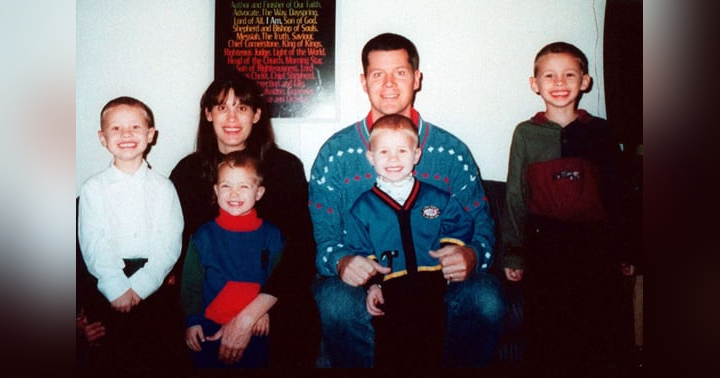Behind the Smile: Inside the Mind of the Happy Face Killer

The Dark Roots of Keith Jesperson’s Childhood
In the 1950s, Selah, Washington, wasn’t just a small, picturesque town—it was a battleground for young Keith Jesperson. Towering over his peers and burdened with a quiet, shy demeanor, Keith was caught between two versions of himself: the boy he was and the boy his father, Leslie Samuel “Les” Jesperson, demanded him to be.
Les had a firm philosophy about raising boys: strength defined their worth. If that strength didn’t come naturally, it would be instilled—forcefully. Instead of protecting his son from bullies, Les turned his rage inward, punishing Keith for being a victim. A belt was his weapon of choice, wielded publicly for maximum humiliation. On one occasion, Les went even further, administering an electric shock as punishment. This wasn’t discipline; it was brutality masquerading as fatherhood.
But Les wasn’t entirely stingy with his approval. He saved it for one thing: violence. When Keith, at the tender age of five, began torturing animals—birds, stray pets, anything he could catch—Les rewarded him with pride. For Keith, this twisted encouragement unlocked something dark. The act of killing gave him a sense of control, a fleeting balm for the chaos his father created.
The violence became intoxicating. And as Keith’s young mind tried to make sense of the world, he began to ask himself a horrifying question: If killing an animal feels this good, what would it feel like to kill a person?
At just five years old, Keith Jesperson was already teetering on the edge of darkness, his warped upbringing ensuring he wouldn’t be able to step back.
Early Attempts at Violence: Keith Jesperson’s Troubled Adolescence
By the time Keith Jesperson was ten years old, his life already read like a primer for dysfunction. One of his few friends, Martin, seemed more like a frenemy, often getting the pair into trouble and then masterfully pinning the blame squarely on Keith. In most households, this might have earned a stern lecture, but in the Jesperson family, it meant beatings—public ones. Les Jesperson was nothing if not consistent in his cruelty, and Martin got a front-row seat.
One day, when Martin once again shifted the blame onto Keith, something in Keith snapped. Confronting his friend the only way he’d been taught—through violence—Keith attacked. While it may have looked like a typical playground fight between two ten-year-olds, Keith later admitted that he wasn’t just trying to hurt Martin. He was trying to kill him. Though Martin survived, Keith walked away with something chilling: an appetite. This marked his first deliberate attempt to take a human life, and while it was unsuccessful, it left him wanting more.
A year later, that hunger resurfaced. Keith was swimming with another so-called friend—a boy who, like others in his orbit, couldn’t resist bullying him. As Keith swam, the boy ambushed him, forcing his head underwater until Keith passed out. Though Keith survived, the incident cemented his need for revenge. Weeks later, at a local pool, Keith returned the favor. Sneaking up on his friend, he held the boy’s head underwater with brutal determination. It took lifeguards to separate them, but by then, the intent was clear: Keith wanted him dead.
That attempt, like the first, ended in failure. Keith still didn’t know what it truly felt like to kill another person, but he was no less determined. For now, though, he kept those dark urges to himself.
A New Life, But Old Tendencies
As Keith grew older, life seemed to follow a more conventional path—on the surface. He graduated from high school, met Rose Hucke, and by the age of twenty, he was married with three children. The young family settled into a quaint farmhouse that bordered an apple orchard. Keith took a job as a truck driver, providing for his family and putting on the façade of a normal, hardworking father.
But lurking beneath the surface was a man shaped by violence, revenge, and an unrelenting thirst for control. What seemed like a fresh start was merely a pause in the storm.
A Farmhouse Far From Idyllic: The Darkness Behind Closed Doors
On the surface, the Jesperson family’s farmhouse, bordered by an apple orchard, seemed like the perfect place to raise children. With fresh air, open space, and plenty of wildlife, it was a slice of rural Americana. But the reality of life inside those walls was far from idyllic.
Melissa Jesperson, Keith’s eldest daughter, would later share a chilling memory from her childhood. One day, while playing in the cellar, she discovered a litter of stray kittens. Thrilled by her find, she brought them outside, eager to play with her new furry friends. But her joy quickly turned to horror when Keith spotted the kittens and saw them as an opportunity to relive his childhood cruelty.
Without hesitation, he grabbed the kittens, hanging them from the clothesline as if they were laundry. Melissa could only watch in terror as the helpless animals clawed and screamed, struggling to free themselves. Her pleas for mercy went unanswered, met instead with Keith’s laughter. Desperate, she ran to get her mother, Rose. But by the time Rose arrived, the kittens were dead, their tiny bodies discarded on the ground. Keith’s twisted sense of amusement had run its course.
Rose was horrified, but like so many times before, she chose to stay silent. She had three children to protect, and for now, that meant keeping the family together. But Keith’s sadism wasn’t the only crack in their marriage. When strange women began calling the house asking for Keith, Rose knew he was having affairs.
She waited for him to leave on one of his long-haul trucking jobs, packed up the kids, and drove 200 miles to her parents’ home in Spokane, Washington. The marriage was over, but for Keith, it was barely a hiccup. By 35, he was divorced, unburdened by family ties, and free to indulge his darkest impulses on the open road.
The Murder of Taunja Bennett: The Start of Keith Jesperson’s Killing Spree
In 1990, Keith Jesperson’s newfound freedom came at a steep cost for 23-year-old Taunja Bennett. While on a trucking job in Portland, Oregon, Keith met Taunja at a bar. He invited her back to his rental, where an argument erupted. Fueled by his deeply ingrained tendency to solve conflict with violence, Keith attacked Taunja, killing her in the process. Using his knowledge of highways and backroads, he disposed of her body and any evidence linking him to the crime.
But while Keith had escaped detection, the investigation into Taunja’s murder took an unexpected turn. Laverne Pavlinac, trapped in an abusive relationship, saw the case as her way out. She fabricated a story, claiming her boyfriend, John Sosnovske, had killed Taunja and forced her to help. She even provided details she’d read in the news to make her tale more convincing.
Her plan backfired spectacularly. John was sentenced to life in prison, and Laverne received a ten-year sentence. Despite her later admissions that she had lied, the damage was done. Meanwhile, Keith couldn’t believe his luck—not only had he avoided suspicion, but two innocent people were taking the fall for his crime.
The Birth of “The Happy Face Killer”
For a while, Keith reveled in his anonymity. But his father’s shadow still loomed large in his mind. If no one knew he was responsible for the murders, where was the recognition? The validation? To satisfy this craving, Keith began leaving confessions in truck stop bathroom stalls. When those didn’t get the attention he wanted, he escalated, sending letters to newspapers and police departments. Each one was signed with a smiley face, earning him the moniker “The Happy Face Killer.”
But his desperate attempts to claim credit didn’t bring law enforcement any closer to catching him. Instead, Keith remained free—and ready to kill again.
A Trail of Victims Across the Country
Keith Jesperson’s second known victim was a woman he identified only as Claudia, found near Blythe, California, in the summer of 1992. She had been raped and strangled. Shortly after, he murdered Cynthia Lyn Rose in Turlock, California, claiming she had trespassed into his truck while he slept. Then came Laurie Ann Pentland, a woman from Salem, Oregon, who was brutally killed after allegedly trying to double her fee for her services.
In 1993, Patricia Skiple’s body was discovered. Initially ruled an overdose, it was later revealed to be yet another of Keith’s victims. And in 2023, DNA testing finally identified one of his last known victims, Suzanne L. Kjellenberg, a woman he murdered decades earlier in Crestview, Florida.
The Capture of Keith Jesperson: The End of the Road
In 1995, Keith Jesperson’s reign of terror came to an end with the murder of Julie Winningham, his girlfriend at the time. During initial police interviews, Keith clung to his father’s lessons, staying stoic and refusing to answer any questions. The police had no choice but to let him go.
But Keith’s composure cracked in the weeks that followed. He felt the pressure mounting and made multiple failed attempts to take his own life. Finally, he turned himself in. Over the course of his confession, Keith admitted to killing over 160 people, though authorities could only confirm eight. Among those was Taunja Bennett, whose murder had initially landed Laverne Pavlinac and John Sosnovske in prison. Keith provided details only the killer would know, including the location of Taunja’s purse, leading to their release.
Keith Jesperson was sentenced to life in prison without the possibility of parole. From his idyllic farmhouse beginnings to his gruesome cross-country crimes, Keith’s story is a grim reminder of how unchecked violence can ripple outward, leaving destruction in its wake.




